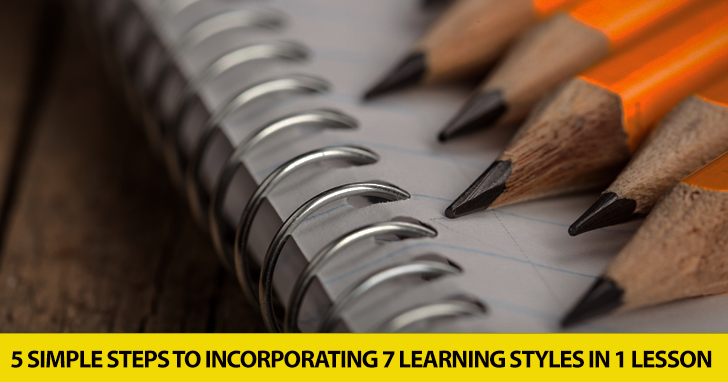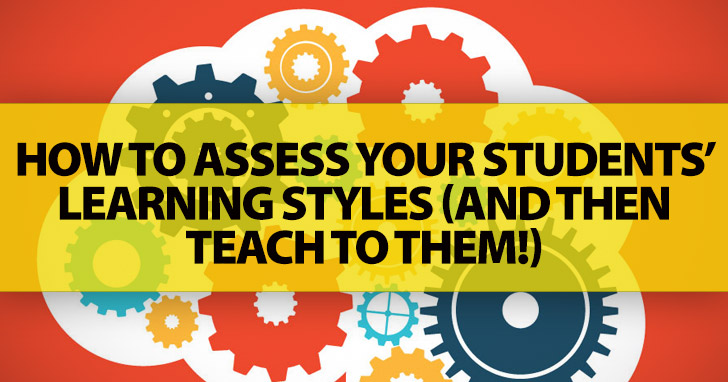Seven in One Blow: 5 Simple Steps to Incorporating 7 Learning Styles in One Lesson


In fact, have you ever had a student who just didn’t seem to connect to the way you were teaching no matter what you said? If so, it may be because that student had a learning style that didn’t connect with your personal teaching style. Learning styles are intangible, but they are so important for making sure students get what you are teaching. That’s why it’s worth taking some time to determine what learning style each of your students seems to prefer. You don’t have to take extra class time to do it. Just observe your students (you do anyway) and see which of the following categories seems to best describe them. Then make sure you give them just what they need to flourish as language learners.

Visual learners prefer working with images or spacial relations as they learn. ESL students who are visual learners might prefer a picture dictionary to a written one. Or you might find them highlighting with different colors or creating a highly organized system of note organization. For these learners, letting them see what you are teaching is key. Bring in objects when you teach new vocabulary. Write everything on the board. Use different colors or fonts when giving informational handouts. Anything you can do to stimulate their vision will help these learners understand and retain the information you are giving them.
Aural learners use sound to help them process and retain information. These ESL students may stand out as good listeners, or they might have no problem understanding material you present in a lecture though they struggle to answer questions on paper. They may often wear headphones and listen to music both in English and their native languages. To make the most of this learning style, be sure to present information in a spoken manner. But don’t stop there. Tie songs and jingles into your lessons whenever possible. Talk about rhythm and rhyme. You may even want to play soft background music while students are working independently or in groups. Aural learners tend to do well in traditional classrooms since most information is presented orally, but make sure you add special touches to your teaching style to really connect with the students who learn this way.
Do you have any ESL students who just seem to pick up the language without even trying? They are likely verbal learners who thrive on using with words. Their skills with language will most likely come out in both oral and written modes. These are your natural language learners, and they may even be multilingual already. For these learners, incorporate both speaking and writing into assignments. Include group activities in class like discussions or skit writing and performing. The more these students can use words, the more they will learn both inside and outside class. Write your notes on the board or give handouts, too, and you will be impressed with how easily these students learn.
Physical learners are also known as kinesthetic learners. These students learn best when their hands and bodies are involved. You might recognize these ESL students by their inability to sit still, by their love of hand motions or working with manipulatives. The more you can get these students moving as they learn, the more they will remember and be able to use English in real life. One of the best ways to teach physical learners is the Total Physical Response technique. You can also include songs with hand motions and classroom manipulatives to help these students physically connect with the information they are learning. Make your classroom as full of hands on manipulatives as you can, and have learning centers available where these students can really get their hands into what they are learning.
Logical learners are mathematical, analytical, and look for the reasons language acts the way it does. These are the students who ask deeper questions about grammar that might be difficult to answer. They want to know why. They might be engineers, scientists, or business analysts or will take on these professions in the future. To reach these learners, emphasize the whys behind the whats when it comes to language patterns. If you can, give reasons for grammar rules and explain how the brain is processing language (so English language rules make sense). These students will value discussions about language acquisition, phonological rules, psycholinguistics, and syntax. You might want to use sentence trees/diagrams in class to help these students see the underlying structure behind spoken English.
Social learners, also known as interpersonal learners, learn best when they work with other people. You might see these ESL students flourishing in groups and on partner projects but struggling when they are tackling questions on their own. These are the students who are always talking in class and who are social butterflies. Many strong extroverts are also social learners. For these students, group assignments are key. Using activities where students must work together to understand something or reach a goal will get these students interested and involved in any lesson. Role plays are a great method of social language use. So are jigsaws. Getting these students out of the classroom and into the “real world” to use the English that they know will also hit them in just the right educational place.
Solitary learners, also known as intrapersonal learners, may seem uninterested in the very activities that social learners love. That is because these learners prefer working independently and studying on their own. You may identify these learners by their disinterest in group activities or their reluctance to pair up with classmates. They may often have their head in a book trying to puzzle out information you may have already presented to your class. To encourage the most learning in these students, give them time to work on their own. Setting up learning centers and offering free reading periods are great for giving these learners time to figure things out for themselves. Don’t take it personally if they are disinterested in your teaching or classroom activities with other students. Giving them the space they need to puzzle things out on their own will make all the difference in their English studies.
One of an ESL teacher’s greatest challenges is understanding and teaching to all the different learning styles exhibited in their students. And even though it is a lot of work, it is worth taking the time and making the effort to really reach students where they are. If you do, you will see your students achieve success in their language studies, and they will retain and use the language they learn for many years to come.
Share them in the comments below.